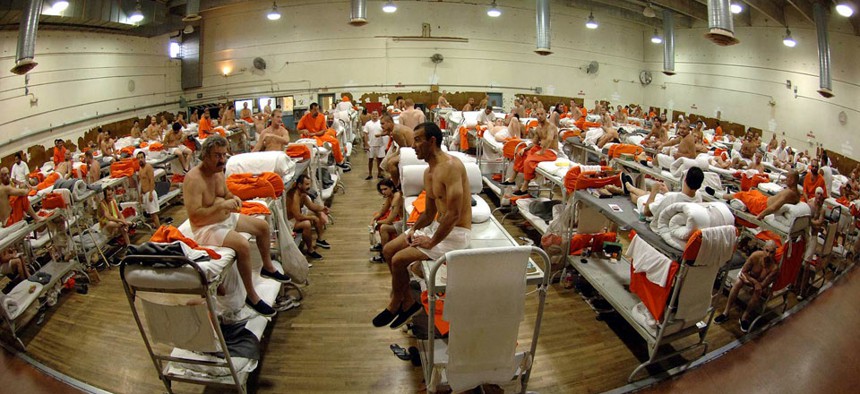
Inmates sit at the California Institute for Men in Chino AP file photo
It's Not Just Federal Prisons: State Prisons Are a Mess, Too
Eric Holder's points on the cost of the U.S. criminal justice hold true at the state level, too.
In Arkansas, there aren't enough prison beds for all the inmates. Tasked with housing 14,753 people, the state's prisons have fallen around 280 beds short, with 1,400 state inmates being held in county jails as of Monday. Arkansas's state prison director told the corrections board that there are 300 beds ready for use, but it would cost $8 million to hire new employees and run the new facilities.
Arkansas isn't the only state with a bed problem: Arizona has been relying on temporary beds to make up for only having 37,000 beds for 41,000 inmates.
When U.S. Attorney General Eric Holder spoke to the American Bar Association about the economic and moral costs of the U.S. criminal justice system last week, he was mainly talking about federal prisons. But prisons at the state and local level aren't in any better shape. While the overall state prison population declined in 2012 by just over 2 percent, there were still more than 1.3 million inmates in the system. That's greater than the population of Maine—or about Washington, D.C., and Alaska combined. In other words, if the state prison population were its own state, it would be the 41st-most populated one in the nation.
If you need more proof of how bleak things are, just look at some of what's happened in the last few weeks.
On July 8, a hunger strike broke out in California prisons over a policy that allowed inmates associated with gangs to live in isolation for long periods of time. State officials say the policy is necessary to curb the influence of prison gangs. Amnesty International calls the policy "an affront to human rights" and says that it "must end."
When the strike began, it included almost 30,000 of the state's 133,000 inmates. That number is down to around 130. On Monday, a federal judge ruled that California will be able to force-feed the remaining strikers.
California's prison problem is also fundamentally economic. In May, a judge ordered California to reduce its inmate population by 9,600 to prevent overcrowding. California unsuccessfully appealed the ruling to the Supreme Court. Gov. Jerry Brown on Monday said that California wouldn't "do a mass release" and a spokesman said the administration is "working with the Legislature to avoid the prospect of inmate releases." That could mean spending hundreds of millions of dollars to stem overcrowding. But even just releasing prisoners can come at a huge cost. According to the LAPD, it costs about $18 million to keep track of felons who are released from state prisons to the counties, and more than half of the thousands who are already released annually are eventually sent back to prison.
Then there's the violence. Five prisons have been placed on lockdown in Illinois in the last week for unrelated incidents after a wave of violence. That includes violence against prison guards. Then there's the rise in suicides. In Washington, D.C., there have been four suicides at the Central Detention Facility in less than a year. In the last decade, there have only been eight suicides total at that facility. A Bureau of Justice Statistics report released this month shows a recent uptick in suicides at local prisons.
Renewing focus on federal prisons is a start, but it doesn't totally address all of the problems in the U.S. criminal justice system.







